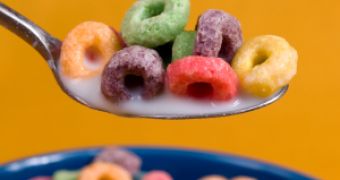Some of the most popular brands of cereals are being marketed as healthy, which makes them ideal for serving them for breakfast to children. As it turns out, reality is far from that, as they contain more sugar than a jam doughnut and double the salt intake recommended daily for an adult, a new survey has concluded, as cited by the Telegraph.
One of the golden rules to buying cereals that will not expand our waist size or not damage our health is never to choose a brand that colors the milk, because that means they’re laden with artificial substances and preservatives. Another rule would be not to purchase those varieties that are very sweet, even if the package says they’re made with honey or something to this tune. Another thing we should keep an eye out for is the salt content.
“An analysis a number of popular breakfast cereals – many of which are marketed as being nutritious – showed that in many cases each bowl contains more than a quarter of the recommended daily sugar intake for an adult. Many cereals also contain high salt levels, with the ten top-selling brands in Britain all containing more salt than a Cadbury Milk Chocolate Cake Bar or a Magnum Classic ice cream. Kellogg’s Crunchy Nut Cornflakes was found to have 13.6g of sugar and 0.5g of salt in every 40g serving,” the Telegraph writes, citing the survey performed by the UK website MySupermarket.
Nestle Shreddies, Weetabix Minis Chocholate Crisp, and Kelloggs’s Special K, Corn Flakes, Rice Crispies and Coco Pops have also made the list of cereals varieties that pose to be healthier than they are, as they surpass the recommended quantity of sugar and salt. The danger is not that they contain so much of both ingredients, but rather the fact that they’re being marketed as “healthy,” which virtually discourages customers from checking the box or label.
“Consumers can end up thinking they are choosing a healthy cereal, often because some sound healthy or simply look healthy because of how they are marketed. Yet, as with any product bought, shoppers need to make sure they read the nutritional information on the packet to understand the content, otherwise they could accidentally be consuming more sugar or salt than planned,” a spokesperson for the aforementioned website explains for the Telegraph.

 14 DAY TRIAL //
14 DAY TRIAL //